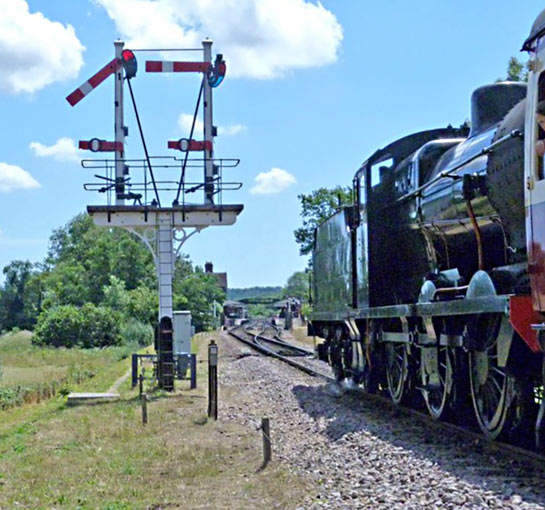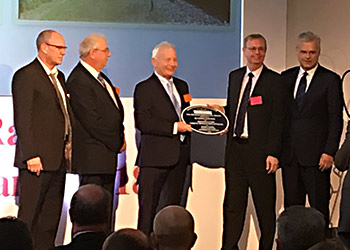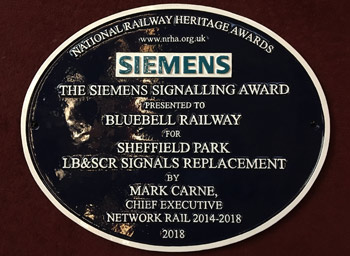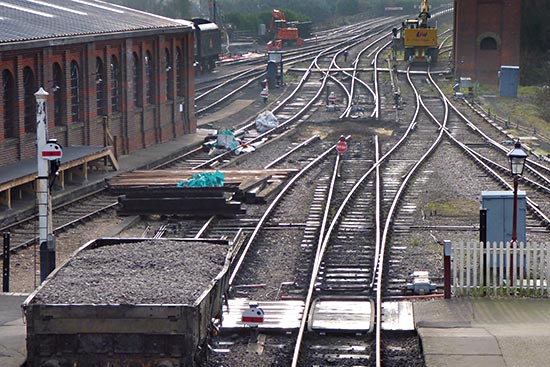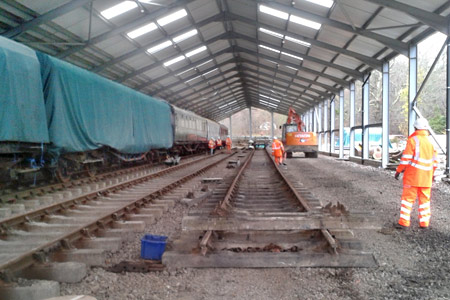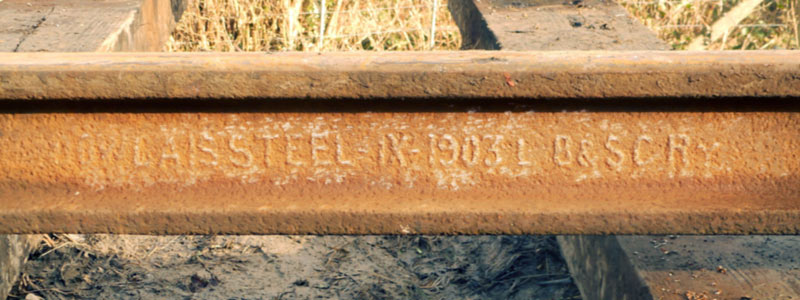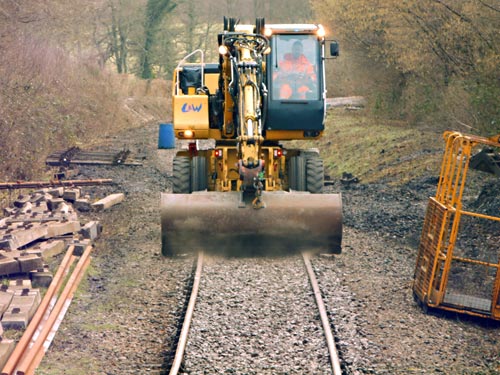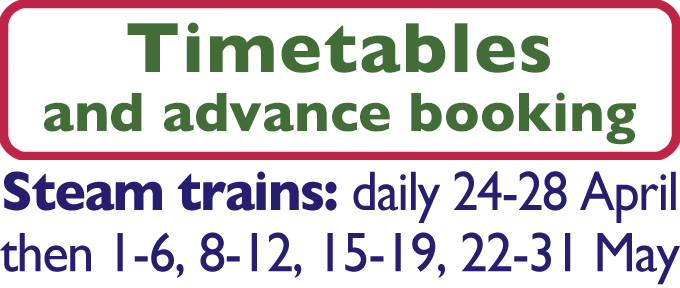

|

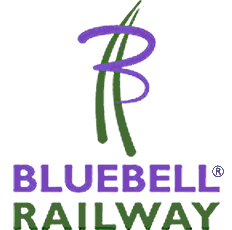
|

|
|
Archive of Infrastucture News: 2013-14 - 2015-16 - 2017 - 2018 - 2019 - 2020 - 2021-22 - 2023 Archive Reports: Northern Extension Project - Permanent Way and Lineside News (2007-2011) - P-Way News (2002-4) 

Track maintenance north of Kingscote Barry Luck, OP4 Project Manager (Infrastructure) Stevenson's have now completed the Heritage Skills Centre framework, and as shown in photo below the roof is now on. There is a little bit of tidying up to be done, but apart from that, this phase of the work is now complete. We are continuing to raise funds for the next stage, which will enable us to complete the walls around the Skill Centre and this side of the shed. In the meantime, the Infrastructure team have been working in the yard, laying trackwork into the shed. Two roads, F and G are complete as seen below, and work has started at the southern end of the salt yard on the next turnout which will lead into roads H and J. Nature is also helping out, with the beginnings plant life showing on the embankment face. 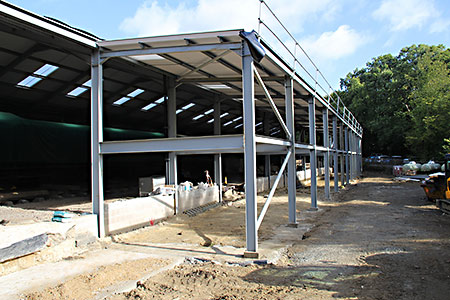
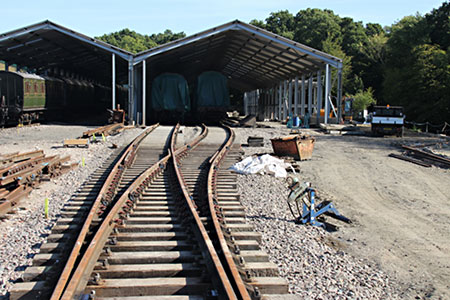
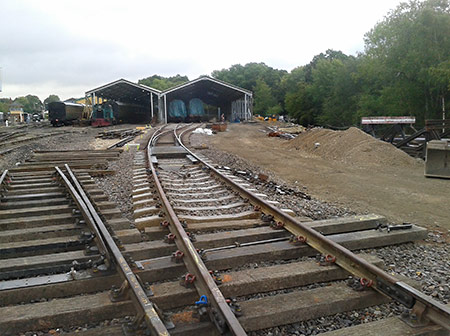
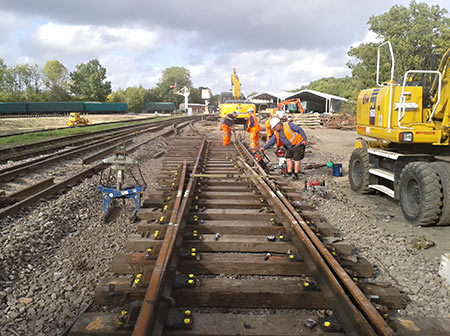
(Barry Luck, Project Manager) The dwarf wall on the eastern side of the shed seen in the next photo is complete as far as we can go for the present, until the Skills Centre framework is complete. The wall above the brickwork will be clad in the same cream and green style as the main existing building. 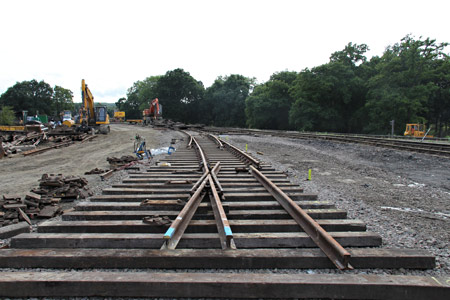
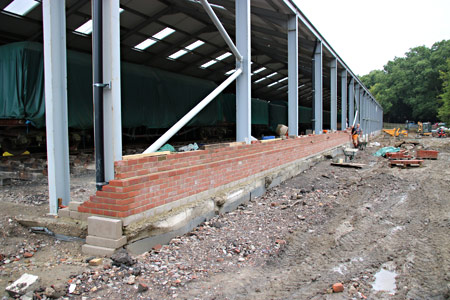
Stevenson's started work on 30 July on the Skills Centre framework. The final concrete pour at the southern end of the ring-beam was completed on 22 August as seen in the next photo, whilst erection of the steelwork started at the northern end a couple of days earlier on 20 August. The final photo shows progress as at 3pm on 23 August with four sections in place. Just one and a half hours later seven columns and roof joists had been erected. As soon as the framework is finished, the infrastructure team will move in to reduce the ground level inside the building to its final level. We will then be able to start work on the ground floor, and continue with the dwarf wall around the building. In the meantime we are continuing to raise funds for cladding along the eastern/northern side of the shed and around the Skill Centre. 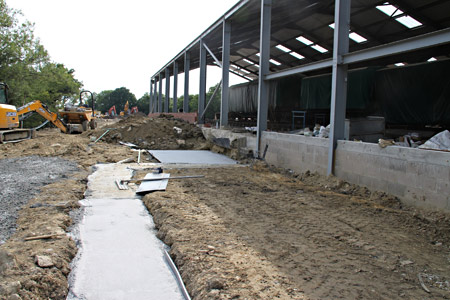
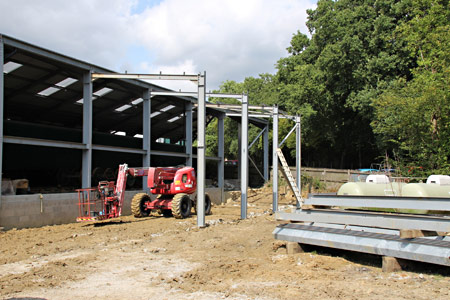
(Barry Luck, Project Manager) 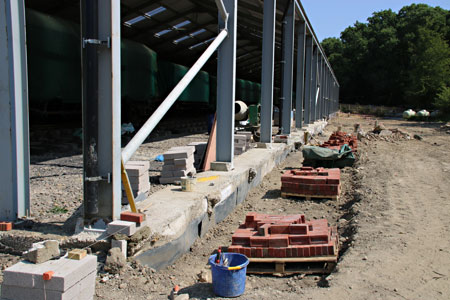
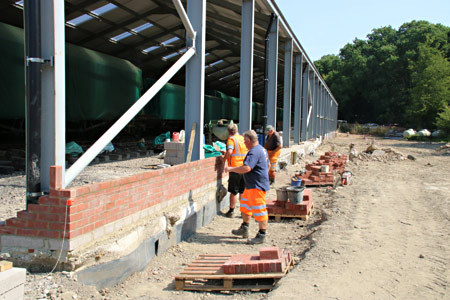
The erection of the steel framework and roof of the Skills Centre is planned to have commenced yesterday. 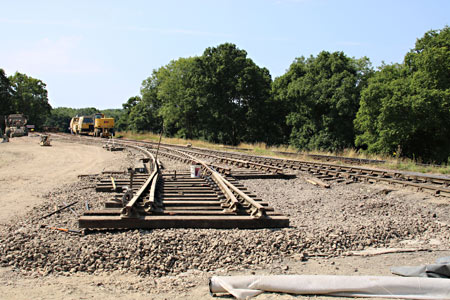
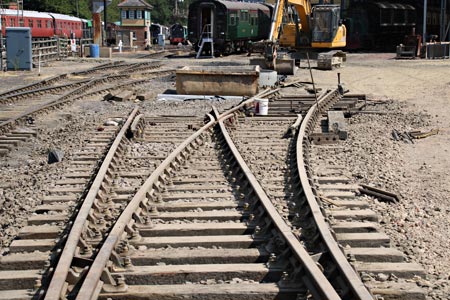
(Barry Luck, Project Manager) 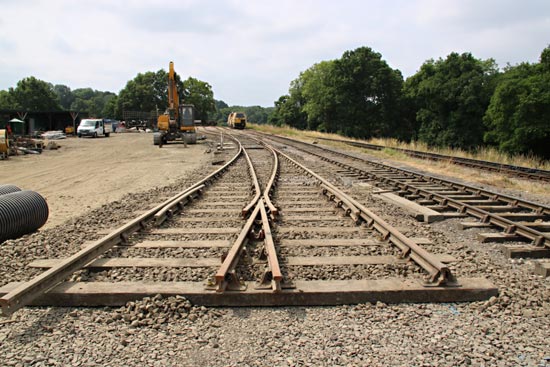 Now that the earthworks to complete the embankment around the edge of the new shed are all but complete, we can turn our minds to the next task - relaying the down yard. The first photo shows one of the turnouts in its final position.
Now that the earthworks to complete the embankment around the edge of the new shed are all but complete, we can turn our minds to the next task - relaying the down yard. The first photo shows one of the turnouts in its final position.
The next photo, below, shows another turnout laid out in the Ardingly triangle. This will be broken down into several component parts before being moved across the line to its final place. Relaying the downyard will cause a degree of disruption to the workings of the C&W maintenance routine, so will require careful planning between C&W and Infrastructure.
The last photo shows the Ardingly triangle being tidied and levelled after the removal of the spoil heap, which has been used to fill the embankment.
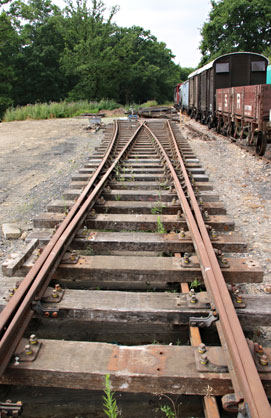
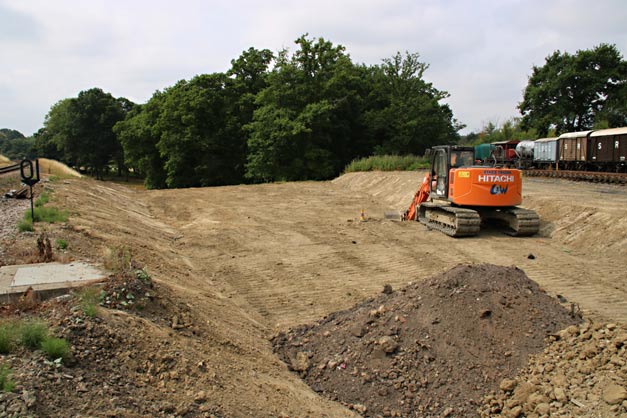
Barry Luck, the project manager, provides three more photos of the OP4 earthworks. 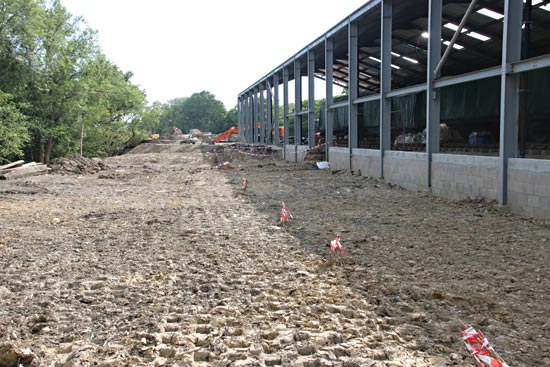 On the right we see the east side of the carriage shed with the pile tops partly exposed, where the Heritage Skills Centre will be constructed. The dimples in the soil in the foreground are made by the heavy "sheep's foot" roller used to compact the soil.
On the right we see the east side of the carriage shed with the pile tops partly exposed, where the Heritage Skills Centre will be constructed. The dimples in the soil in the foreground are made by the heavy "sheep's foot" roller used to compact the soil.
The next stage here is to excavate a trench along the line of the piles, and to cast the ring-beam around the perimeter of the Skills Centre, ready for the steel framework to be erected. The reconstruction and stabilisation of the embankment east of the carriage shed into so-called 'Dingley Dell' is now complete, bar a little bit of tidying up, and filling and re-grading of the top few inches, which will use excavated material from the Skills Centre footings. The first photo below shows the area immediately south of the carriage shed levelled and compacted ready for track laying into the eastern two roads, H & J. The second photo shows the view from the south. 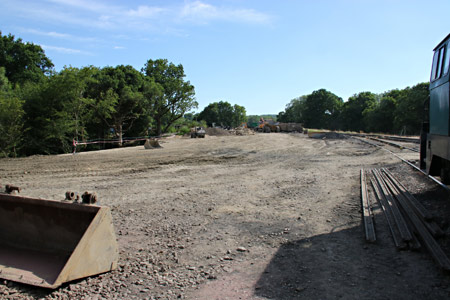
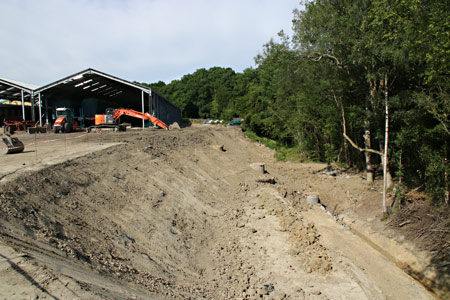
(from Barry Luck, Project Manager) 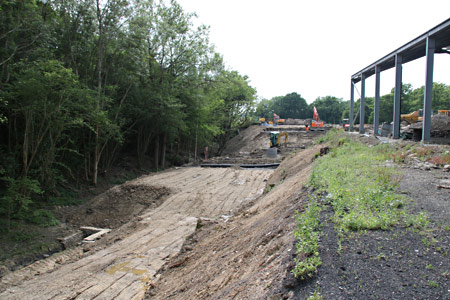
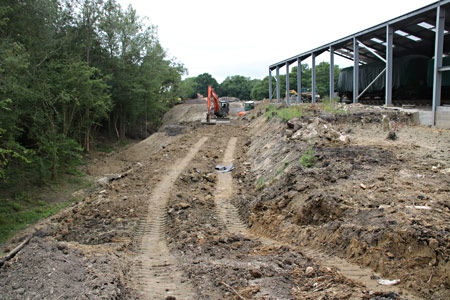
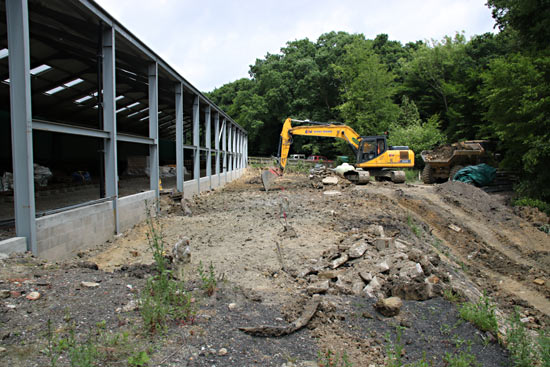
Barry's third photo, on the left, shows the beginning of the excavation in preparation for the erection of the Heritage Skills Centre. The ground here has been lowered by approximately one metre, which gives sufficient height to roof level to accommodate a two-storey structure. The erection of the steelwork is due to start in mid-July. 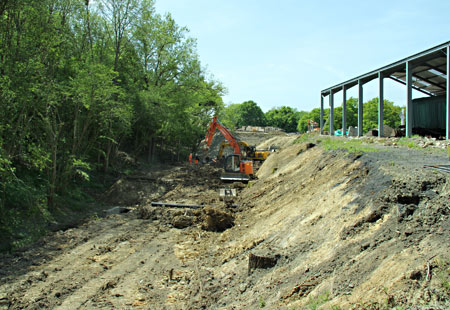
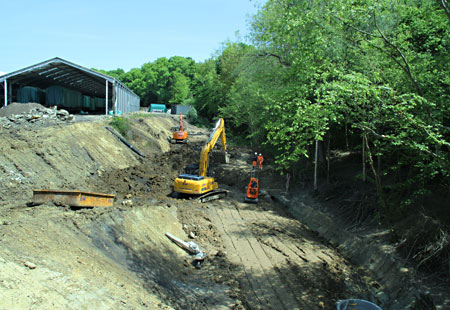 The most obvious outcome is that the spoil heap south of the shed has now gone, and the embankment at the south end of so-called "Dingley Dell" has been rebuilt, extending the space available in the yard. The ground south of the shed is "made ground"; that is to say, it is not virgin soil, but it has been built up over many decades by the tipping of loose material. This ground is therefore un-compacted and inherently unstable, slowly slipping into the valley. The removal of the spoil heap has reduced over-burden on the embankment, minimising the risk of further slippage. To stabilise the embankment, material at the bottom has first to be dug out and then replaced in shallow compacted layers, with reinforced Geotech mesh placed between layers to provide additional stability. Before this work can proceed much further, some small-scale piling is required along the edge of the stream to secure the toe of the embankment. This job is likely to commence within the next week, given continued dry weather. Heritage Skills Centre The materials for the framework of the Heritage Skills Centre (HSC), which is being built alongside the OP4 shed, have been on site since the erection of the main shed structure, but no progress has been possible until the ground in this area has been reduced to finished levels.
The detailed design of the HSC is progressing well, and we are currently awaiting Building Regulations approval before proceeding further. Completion of the design will provide details of finished ground levels to the east of the building, and crucially enable the northern and eastern wall cladding to be specified and detailed. OP4 trackwork Work to relay track in the down yard is not strictly part of OP4. Plans are being prepared and components assembled for a new layout that will provide significant improvements in the yard's operational efficiency and also facilitate the shunting of stock into the new shed. However, until a significant proportion of the embankment work has been completed, and the ground stabilised, we can't shunt further carriages into the remaining two roads (H and J). The clearance under Caseford Bridge was a bit tight. During this relay, we have been using the technique of putting new ballast over the old to give us an even firmer trackbed. As this would have compromised clearance even more, the opportunity was taken to lower the trackbed by 4 inches. The work was due to finish last week but the 'Beast from the East' meant we had to stop where we were on the Tuesday and reconnect the track to ensure it was ready for the weekend service (which as it turned out was cancelled, also due to the weather). An attempt at ballasting on Thursday 1st had to be abandoned because the ballast was too frozen to lay. We started again on Monday 5th to complete the work. The section now replaced had some particularly worn track, badly dipped joints, a life expired Insulated Block Joint and the alignment of the curved track south of Keysford Bridge was poor. 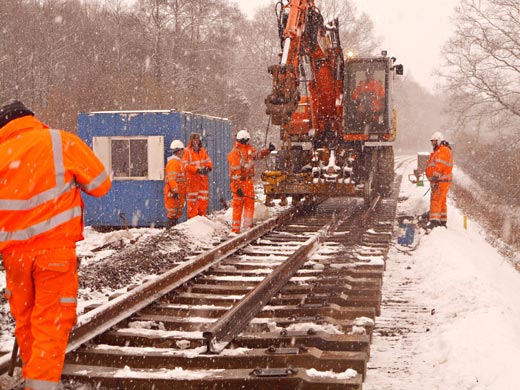
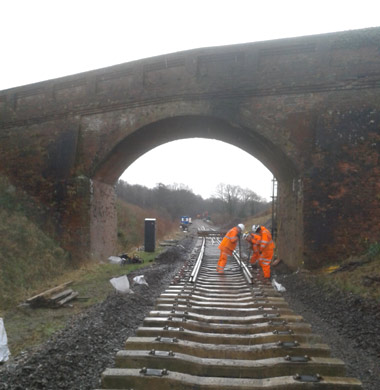
During the rail relay, the old rail to which we were going to connect at the north end of the job turned out to be so worn that we did not have a step plate big enough to lift the head of the rail up high enough to match up with the new rail. Therefore we had to remove it and replace it with a less worn rail and put a step plate either end to make up the step in two goes. A step plate is a fish plate with a joggle in the middle so that it lifts one rail higher than the other so that the top surface of the two rails match up and there is no "clunk" when a wheel passes over it. They normally come in 1/16" steps up to about 3/8" although we don't have any that big (and you have not been able to buy them for 96-pound rail for many decades). The two step-plate solution resolved the problem very well and attention turned to the rail that we took out. It turns out that it was probably one of the original 96-pound rails put in when the line was re-railed from 70-pound to 96-pound near the beginning of the last century. The rail was made in 1903, 115 years ago! Is this the oldest we have still in use? The picture above of the rail shows the age with the rolled notation of "DOWLAIS STEEL - IX-1903 LB&SCRy", which was also found elsewhere on the rail. It has now been used for some of the new fence posts (seen in the 30 January update) protecting the Tremains foot crossing just north of Rock Cutting, with the writing still visible. The last of the ballast has now been dropped and ploughed ready for the tamper to start (hopefully yesterday). A very wide bucket with miniature rail wheels is a new form of plough that we have not used before and has proved to be a very quick way of smoothing out the ballast, as seen in Jon's second photo. 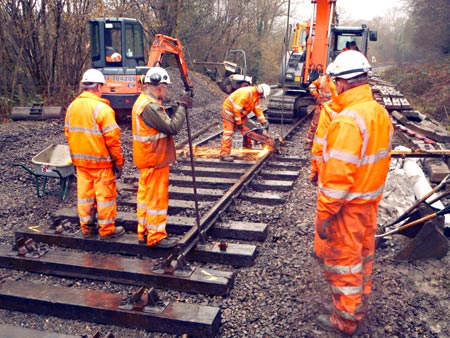
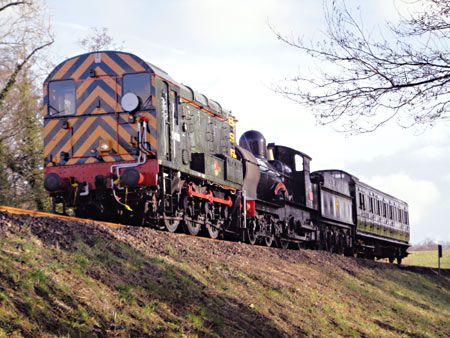
Something in the order of 1000 Tons of ballast needs to be dropped and ploughed into the new track before it can be tamped and with only 20 tons per hopper, that is a lot of train loads. In addition, as part of the relaying task, the foot crossing at Tremains needs to be replaced and as part of the task, the path from the boundary to the crossing has to be fenced. This path is in a very poor state and so a new one is being cut into the embankment with much bigger and better steps. 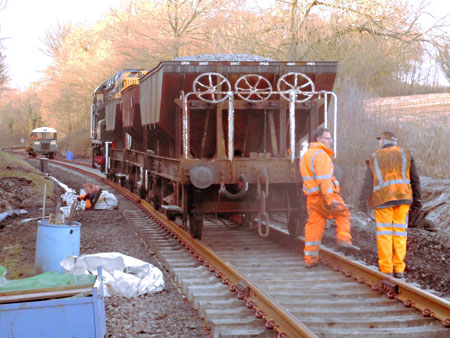
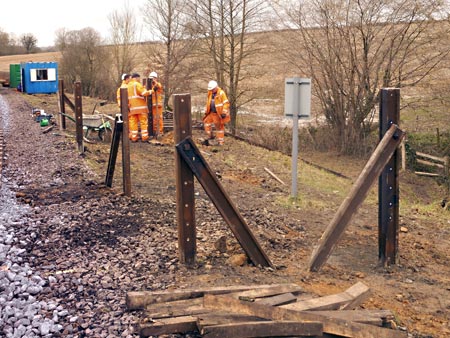
The second photo shows the process of laying the sleepers. Specially constructed wooden spacers are used to ease the task of getting the sleepers in the correct position as they are lifted into place by the digger. 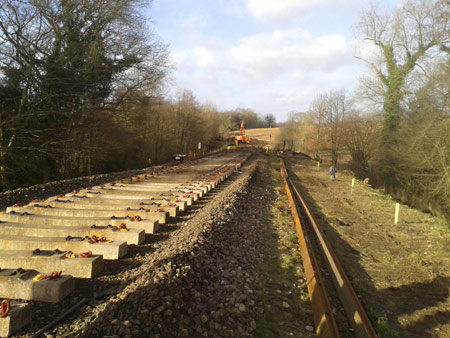
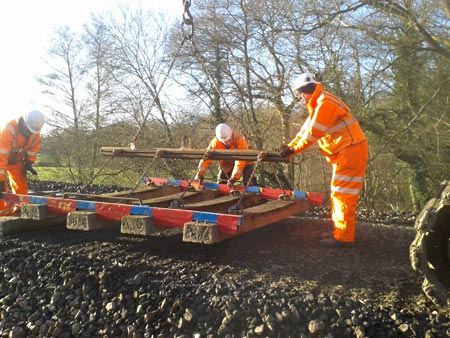
By the end of Wednesday 17 January about half the remaining distance from Tremains to the end of the section had been cleared, levelled and "whacked" ready to have sleepers put down on Thursday. There's some drainage to lay, in the form of a French drain (stone filled invisible ditch) on one side through a small cutting, and then, once the rails are rejoined, hopefully this week, we have to drop lots of ballast, adjust the track alignment and tamp it smooth, carry out any snagging, relay the foot crossing and add some fencing and then clear up. Still lots to do but the project is pretty well on schedule. 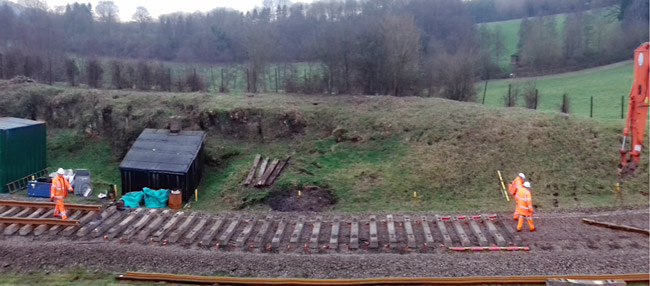
During the six-week closedown, until services resume on 10 February, we are re-laying half a mile of track on either side of Rock Cutting, as seen in Paul Booth's panoramic shot, segments of which are presented here.
The work is funded in part by donations through the Tr(ack) Action Appeal. Further donations are urgently required, since further funds raised will in practice enable more track-work to take place over the coming few months since it really does add to the finite pot of money currently available.
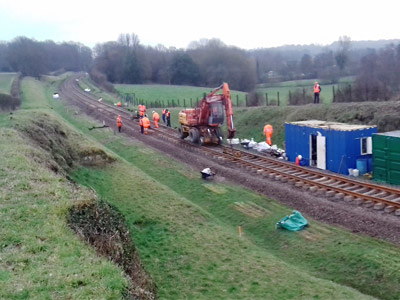
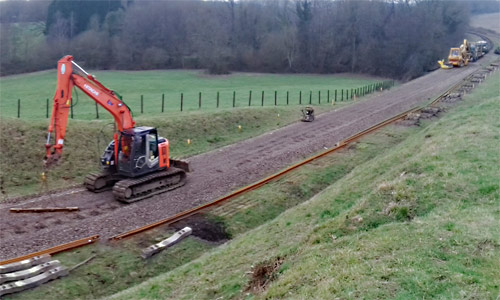
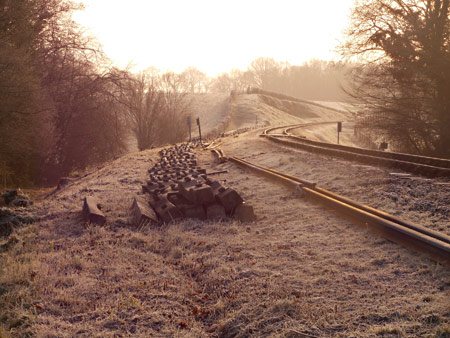
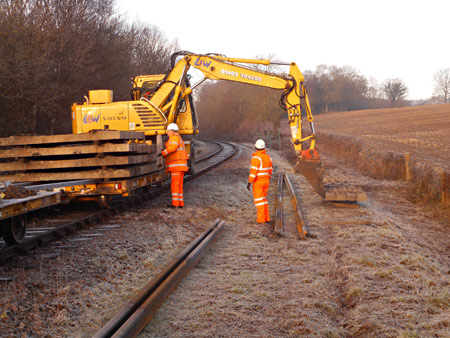


Return to BRPS Home Page, to the Timetable or to Special Events Archive of Infrastucture News: 2013-14 - 2015-16 - 2017 - 2018 - 2019 - 2020 - 2021-22 - 2023 Archive Reports: Northern Extension Project - Permanent Way and Lineside News (2007-2011) - P-Way News (2002-4) Visitor Info. - Museum - Trust - Catering - Contacts - What's New - Projects - Locos - Carriages & Wagons - Signals - History - Other - Links - Search - FAQ Why not become a BRPS Member? - Get more involved as a Volunteer Last updated 21 September 2019. © Copyright BRPS. Privacy Policy |
